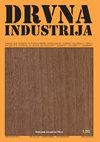用人工神经网络预测高力学性能胶合板的最佳干燥参数
IF 0.8
4区 农林科学
Q4 MATERIALS SCIENCE, PAPER & WOOD
引用次数: 0
摘要
单板干燥是胶合板行业中最影响能源消耗和面板性能(如粘接和弯曲)的制造过程。因此,贴面干燥温度和含水率应准确调整。此外,贴面导热系数的测定与这两个参数同样重要,在制定干燥方案时也应明确其导热系数值。本研究旨在通过人工神经网络(ANN)分析,预测获得最佳力学性能的单板干燥温度、含水率和导热系数的最佳值。用杨木(Populus deltoidesI-77/51)和云杉(Picea orientalis L.)单板和脲醛树脂制作胶合板。根据相关标准测试了单板的导热系数和面板的粘接、抗弯强度和弹性模量。利用人工神经网络对实验数据进行分析,得到最准确、最可靠的预测模型。杨木的最佳干燥温度、含水率和导热系数分别为149℃、6.2%和0.02668 W/mK,云杉为116℃、4.4%和0.02534 W/mK。本文章由计算机程序翻译,如有差异,请以英文原文为准。
Prediction of Optimum Veneer Drying Parameters with Artifi cial Neural Networks for Production of Plywood with High Mechanical Properties
Veneer drying is the manufacturing process in the plywood industry that most affects energy consumption and panel properties such as bonding and bending. Therefore, the veneer drying temperature and moisture content should be accurately adjusted. Moreover, the determination of veneer thermal conductivity is as important as these two parameters and the thermal conductivity values should also be specifi ed when forming the drying programs. This study aimed to predict the optimum values of the veneer drying temperatures, moisture content and thermal conductivity, which gave the best mechanical properties, by artifi cial neural network (ANN) analysis. Poplar (Populus deltoidesI-77/51) and spruce (Picea orientalis L.) veneers and urea formaldehyde (UF) resin were used in the production of plywood. The thermal conductivity of veneer and the bonding, bending strength and elasticity modulus of the panels were tested by the relevant standards. The most accurate and reliable prediction models were obtained by analyzing the experimental data with ANN. The optimum veneer drying temperature, moisture content and thermal conductivity values that gave the best values for all three mechanical properties were 149 °C, 6.2 % and 0.02668 W/mK for poplar and 116 °C, 4.4 % and 0.02534 W/mK for spruce.
求助全文
通过发布文献求助,成功后即可免费获取论文全文。
去求助
来源期刊

Drvna Industrija
MATERIALS SCIENCE, PAPER & WOOD-
CiteScore
1.80
自引率
9.10%
发文量
32
审稿时长
>12 weeks
期刊介绍:
"Drvna industrija" ("Wood Industry") journal publishes original scientific and review papers, short notes, professional papers, conference papers, reports, professional information, bibliographical and survey articles and general notes relating to the forestry exploitation, biology, chemistry, physics and technology of wood, pulp and paper and wood components, including production, management and marketing aspects in the woodworking industry.
 求助内容:
求助内容: 应助结果提醒方式:
应助结果提醒方式:


